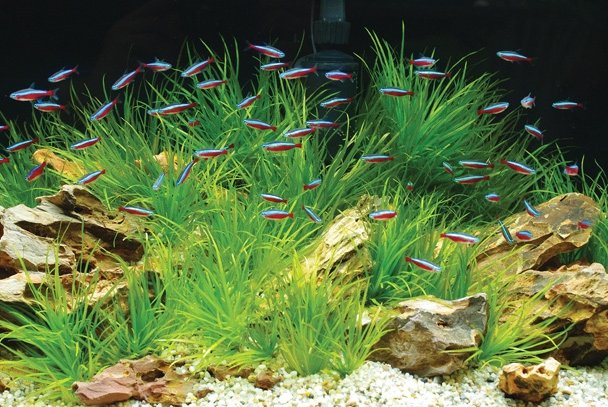
Keeping pet fish no longer consists of putting two goldfish in a glass bowl. To keep fish healthy, they need a clean, eco-friendly aquarium environment.
A splash in the right direction
Keeping pet fish has come a long way from putting two goldfish in a glass bowl. Today, fish are more exotic, aquariums are larger, and they come with a sophisticated array of equipment. With aquariums found in about 12 percent of Canadian households, this hobby has become big business.
Unfortunately, some of the side effects of this growing hobby are not kind to the environment. You can change that. By learning about best and worst industry practices, you can make informed, eco-friendly decisions.
The mechanics—tanks, filters, lights, and other equipment
In 1997 the Lawrence Berkeley National Laboratory studied the energy consumption of aquariums. A small, 10 gallon (38 L) freshwater tank used between 90 and 120 kilowatt hours a year to operate its lights, filters, and aerators—the equivalent of a typical coffeemaker. A bigger, 55 gallon (200 L) freshwater tank uses between 280 and 400 kilowatt hours—or a freezer chest\’s worth of energy.
That\’s just for fish. Add plants, and energy use increases up to 50 percent because plants require more lighting.
Lighting makes up only part of the energy cost. Aquariums, particularly saltwater ones, require extra equipment such as pumps, heaters, chillers, and power heads that can double their energy usage.
For a friendlier eco-footprint
- Think small when it comes to aquarium size. Choose a tank size that fits the number
of full-grown fish you want, but don\’t go overboard. - Use fluorescent, LED, T5, and plasma lamps to reduce energy consumption by about 25
percent. - Buy energy-efficient equipment and keep it in good condition. Poorly maintained
equipment and clogged filters use more energy.
It\’s all about the fish
Because 90 percent of freshwater aquarium fish can be farmed rather than caught in the wild, they\’re often considered a more eco-friendly choice for aquariums. However, some conservationists argue that a well-managed, sustainable, wild-caught trade might have long-term benefits, forcing fishers to maintain healthy ecosystems.
The majority of saltwater fish cannot be farmed. With demand growing for ornamental species, fishers in parts of Southeast Asia are using cyanide to stun and capture the fish. This weakens the fish, leading to a higher mortality rate during transport.
With fewer live fish to meet demand, fishers resort to more intensive harvesting to make up the loss. As a result, some ornamental fish, such as the Banggai cardinalfish, are now endangered. The cyanide also damages the coral where fish and other reef-dwelling organisms live, leading to habitat loss.
Because brightly coloured fish are prized by aquarists, some fish producers use dye. Commonly dyed varieties include the Bubblegum Parrot, Jelly Bean, Blueberry Oscar, Fruit tetra, and those with \”painted\” in their names.
Researchers estimate up to an 80 percent mortality rate. Even fish that survive tend to be stunted and sick because of infections or viruses brought on by the dyeing process.
When buying fish for your aquarium
- Choose varieties of fish that are compatible and that also match your type of aquarium. Don\’t overstock.
- Don\’t buy threatened and endangered species. Check the Reef Protection International\’s Reef Fish Guide (ReefProtect.org) for information on species\’ survivability, abundance, and availability.
- Learn the natural colours of tropical fish to avoid buying unnatural dyed or painted ones.
- Use only reputable sources and buy species that have been captured using hand nets and humanely transported. Many fish die during transportation because of long flights, poor handling, stale water, and improper packing methods.
- Shop at stores that acclimatize fish to their new habitat before selling them. Skipping this step increases mortality rates.
- Contact local hobby groups to see if anyone has home-bred fish to buy or trade.
Coral—beautiful but endangered
Coral, also called live rock, is increasingly used in saltwater tanks because it cleans the water, provides a habitat for some species, and looks beautiful. Unfortunately, worldwide demand by aquarists may be destroying the dwindling coral reefs. Several countries, including the United States and Japan, have banned coral harvesting from their waters, putting more pressure on other reefs.
Conservationists want to ban trade in coral because it destroys marine life habitats and undermines the reef structure. Since as much as 60 percent of harvested coral is rejected by buyers, it also creates huge amounts of waste.
Medical researchers are against the trade because they believe coral reefs might yield a variety of new drugs such as antibiotics, anticancer agents, and antifungals. Destroying the reefs could wipe out those medical advances.
Instead of buying live coral:
- Buy farmed coral that is grown in tanks.
- Buy cultivated rock, which is produced by suspending pumice pellets over existing reefs until the pellets are covered with algae, like real coral.
Both farmed and cultivated rock work as effectively as wild live rock in purifying aquariums, without damaging natural reef systems.
The bottom line
If you\’ve ever sat mesmerized in front of an aquarium, you can understand why several studies over the years have concluded that watching fish swim can lower blood pressure and be as relaxing as meditation. According to the website Autism Today, watching fish can help autistic children calm down, focus better, improve their learning skills, and fall asleep more easily.
While aquariums are beautiful and beneficial to our health, it\’s up to us to make sure the beauty and health benefits don\’t come at the expense of the fish and the environment.
How to learn more about eco-aquariums
Do your research:
- Contact the Marine Aquarium Societies of North America (masna.org) to find a hobbyist club. Members can direct you to local pet and aquarium stores whose staffs know about fish, aquariums, equipment, maintenance, and sustainability issues.
- Talk to staff at pet stores. Some stores have pamphlets on setting up aquariums and fish care. Others post information on the fish tanks to help you choose the best fish for your experience level and let you know what types of environment are needed for different species.
- Go online to aquaticcommunity.com, aquariumlife.net, and aquariumpros.com for articles and blogs.
- Read BowTie Inc. and TFH Publications for excellent information on aquariums.



